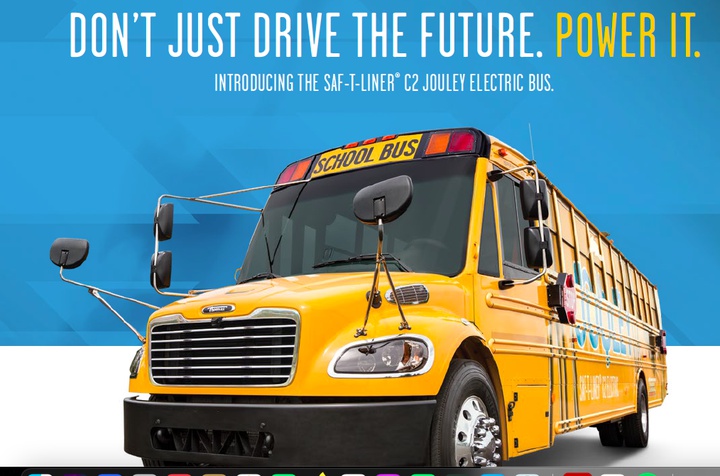Jessica Cejnar / Friday, Jan. 29, 2021 @ 1:18 p.m. / Education
Del Norte Unified Adds Electric Buses To Its Fleet

DNUSD will add two Thomas Jouley electric buses to its fleet. Image courtesy of DNUSD
Del Norte Unified School District is adding two electric school buses to its fleet.
Four trustees on Thursday approved the purchase of two Thomas Jouley buses, each capable of holding 72 passengers, along with the infrastructure needed to house and charge them. DNUSD Board President Angela Greenough was absent.
In addition to the two buses, the district will install a 60 kilowatt DC fast charging station with two dispensers and will bring metered three-phase electricity to a new transformer near the Del Norte High School football field, DNUSD's transportation director, Derrick Campbell said.
The project will cost a total of $875,000. The district will pay for the project with a $762,568 California Energy Commission grant, Campbell said.
The district will have to pick up the remaining $117,600, though Campbell asked for $150,000 from the school board.
“I would like camera systems to be put in the buses,” he said. “And I would like one of those buses to have a wheelchair lift. And that leaves us a little bit of leeway in case there's more infrastructure cost that we don't foresee.”
The project will be paid for out of the district’s home-to-school transportation funding. According to Assistant Superintendent of Business Jeff Napier, that money has already been budgeted for.
With about 250 elementary students engaged in full distance learning as a result of the COVID-19 pandemic, DNUSD buses haven’t been running at full capacity, Superintendent Jeff Harris told trustees. The district has lost a route and on Friday all students are engaged in distance learning, he said.
Harris said he also thinks funding for transportation could diminish once schools are able to fully reopen. He said he was also researching how transit agencies have switched to electric vehicles.
“In the 2015 data, it was about two and a half times cheaper to run an electric bus than it was to run a diesel bus,” Harris said. “Even if we spend $150,000, to-date we’ve saved $200,000 and there are more savings potentially in the next few months.”
Campbell also pointed out that DNUSD has paid $200,000 less than it would normally pay for transportation because bus routes have shrunk due to schools using restricted in-person learning because of the COVID-19 pandemic. A lack of staff at the start of the school year also saved the district money, he said.
“For the future, the savings per year of an electric bus, and I’m getting this from Thomas’s literature, is about $200,000 a year in fuel and about $400,000 a year in maintenance,” Campbell said. “The reason the maintenance is so much less is the bus doesn’t have oil. There are no filters, no transmission — there's a lot fewer things to break and a lot fewer things to maintain.”
One future cost, however, will be replacing the battery, Campbell said. The batteries run at 100 percent power for about eight years after which they decrease to 80 percent power, which means the bus will go fewer miles. They cost about $60,000 to replace, he said.
Thomas Jouleys can go about 135 miles on one charge and take about two to two and a half hours to charge with a DC Fast Charger, Campbell said.
“Realistically it can go about 270 miles in a day, which is much more than most of our routes,” he said. “If we're at 80 percent of that, it’s still a viable bus. We just have to figure for the replacement of those batteries. Given the savings in maintenance I think it's worth it.”
Campbell said he also researched buses from The Lion Electric Co. and Blue Bird Corporation. With the former, he said he wasn’t impressed with its hydraulic braking and cable brake system or its use of fiberglass.
Campbell said he test drove a Blue Bird bus in Fortuna and was warned not to stop on a hill because “I would have to go back down the hill backwards and start up again in order for the bus to go again.”
The Blue Bird bus also lacked an anti-roll back feature, meaning it could roll backwards when it was parked, Campbell said.
“Both of these companies rushed through R&D and got their buses out first so they could get money for all the grant money coming out,” he said. “Thomas had an anti-rollback feature, the buses have air brakes and there's a two-speed transmission so you will be able to go forward.”
The DC fast charger will also be able to charge 16 buses, according to Campbell. But he said he didn’t want to completely eliminate the district’s diesel buses.
CLICK TO MANAGE